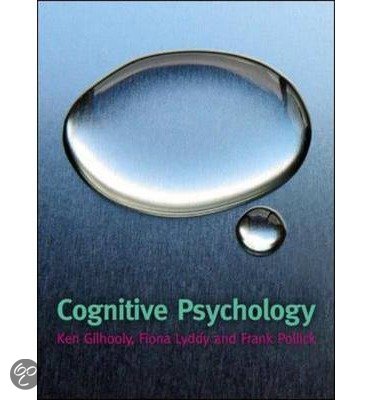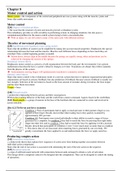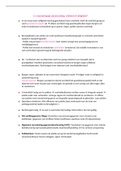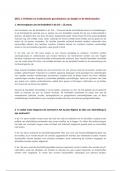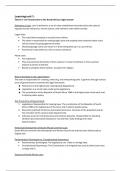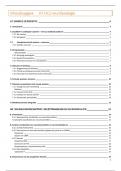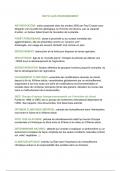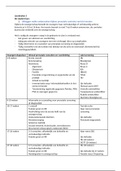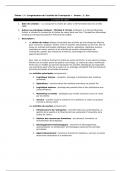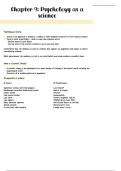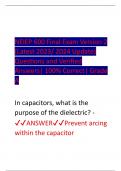Motor control and action
Motor system = the components of the central and peripheral nervous systems along with the muscles, joints and
bones that enable movement.
Motor control
[236] Degrees of freedom problem
= The issue that the structure of joints and muscles provide a redundant system.
This redundancy provides us with versatility in performing actions in changing situations, but also poses a
computational problem for the motor control system trying to form a movement plan.
➔ With an injury we can still achieve many of the same tasks with different motions.
Theories of movement planning
[238] Equilibrium point hypothesis (mass spring model)
States that the problem of control can be simplified by taking into account muscle properties. Emphasizes the special
relationship between the brain and the muscles. Muscles exert different forces depending on how much they are
stretched. Only a stable beginning posture is needed.
➔ Saloon doors: always align in the middle because the springs are equally strong; other end positions can be
achieved by changing the tension of the springs.
Dynamical systems theory
Emphasizes motor control as a process of self-organization between the body and the environment. Uses special
mathematics that describe how a system’s behavior changes over time. Transitions are abrupt: they follow naturally
from the physics of the system.
➔ Antisymmetric moving fingers will spontaneously transition to symmetric motion.
Optimal control theory
States that motor control is the evolutionary result of a nervous system that tries to optimize organizational principles.
Adjustments are based on sensory feedback, but also prediction of feedback (because sensory feedback is usually not
fast enough). Selection of the movement is based on the least amount of mistakes during execution, the least torque
and the most fluent movement.
Torque = force
[240] Forward models
= predict the relationship between actions and their consequences.
Predicts the resulting behavior of the body and the world from a motor command. Aspects based in the cerebellum.
[241] Basal ganglia = a group of neurons in the base of the forebrain that are connected to cortex and involved in
action selection.
[Box 8.2] Tit-for-tat and force escalation
Condition 1: Pairs of participants had to apply as much pressure to their partners finger as was
applied to their finger. Results showed that when trading forces they quickly escalated by
approximately 38% per turn.
Condition 2/3: Participants were tested individually in their ability to match a range of forces
generated by a computer. In condition 2 they had to match the force by pressing their right index
finger into their left, and in condition 3 they had to match the force by applying it with a joystick.
Results showed that participants in condition 2 were 3 were much more accurate than in condition
2. This shows that we are inaccurate when matching forces generated by our own body. We
greatly overestimate the force applied to us and underestimate the force we apply ourselves.
Producing complex action
[245] Associative chain theory
= a behaviorist theory that explains how sequences of action arise from linking together associations between
individual action components.
States that the end of one action is associated with stimulating the start of the next action in the sequence.
[247] Recurrent networks
= a type of artificial neural network with connections between units arranged to obtain a cycle of activation.
This design allows a temporal context to be designed into the computation. They can be designed to control the timing
of operations.
,[Box 8.4] Choking – when actions let us down
Choking = the occurrence of inferior performance despite striving and incentives for superior performance.
• Conscious processing hypothesis (CPH): performance decreases because increasing anxiety leads to a disruption
of automatic processing. Because of this, performers switch to the conscious novice type of action, instead of their
normal advanced style.
• Processing efficiency theory (PET): performance decreases because other activities, such as anxiety, begin to
consume resources, which leaves less resources available for performing the action. In cases of low stress, effort
can be increased to compensate for the lack of cognitive ability.
Brain damage and action production
[250] Frontal cortex
Responsible for action planning. The coordination of action is set in an organized manner across the anatomy of the
frontal cortex: high level control of planning is performed in anterior portions, moving to the motor cortex for lower
levels.
Premotor cortex
Involved in planning movements.
Motor cortex
Involved in actually executing the movements.
[251] Apraxia
= a neurological condition where a person loses the ability to perform activities that they are physically able and
willing to do.
Caused by damage to the frontal and/or parietal lobes, the basal ganglia or connecting structures.
Ideomotor apraxia = difficulty with planning of actions without the presence of relevant stimuli; inability to
pantomime tool use and gesture when verbally instructed to do so.
Theories of action representation
[252] Cognitive sandwich
= the view that perception and action are like slices of bread that surround cognition as the filling of a sandwich.
This emphasizes that motor processes are isolated.
➔ Sensory codes are Spanish and motor codes are English → obtaining formal translations to send between sensory
and motor codes.
Ideomotor theory
Proposes that the mind can control the body to produce an action by thinking about the consequences of an action.
[253] Common coding
Proposes that action production and perception share certain representations of actions in the world.
➔ Sensory codes are Spanish and motor codes are English → add a manager that speaks both to mediate
communication.
[255] Mirror neurons
= neurons that represent both the sensory aspects of perceiving actions as well as motor aspects of producing them.
They are sensitive performing an action and viewing the action being performed by another. They are proposed to be
important for: the evolution of language, observational learning, and empathy.
[Box 8.6] Using dance to study action representation
Calvo-Merino used dance to study how the neural basis of action representation changes with expertise. fMRI was
used to examine brain activity of male and female dancers when viewing gender-specific ballet movements. Because
some movements are only performed by one gender, expertise will only be found in that gender. Results showed
different brain activity when dancers viewed moves from their own gender, compared to opposite-gender moves.
[258] Embodied view of cognition
States that our brains don’t function in isolation: perception, action, your body, and the environment play a role.
Chapter 9
Problem solving
Problem solving = achieving an end or goal.
, Problems and problem types
[264] Characteristics of problems
Problems can be well-defined/ill-defined, knowledge-rich/knowledge-lean, non-adversary/adversary.
Well-defined = when starting conditions, actions available and goals are completely specified.
Ill-defined = when starting conditions, actions available or goals are not completely specified.
Knowledge-rich problems = problems that require extensive specialist knowledge.
Knowledge-lean problems = problems that do not require specialist knowledge. (puzzles)
Non-adversary = when the solver is dealing with inert problem materials with no rational opponent.
Adversary = when the solver has to deal with a rational opponent. (board games)
Gestalt approach
[265] Gestalt approach to thinking
States that problems solving is like perceiving a new pattern in an ambiguous drawing; restructuring is the key. It
stresses the role of insight and understanding in problem solving.
Restructuring = changing how one represents a problem.
Insight = a restructuring of a problem that makes the solution obvious and understandable.
[267] Set effect and functional fixity
Set effect = a tendency to persist with one approach to a problem.
Functional fixity = a difficulty in thinking of a novel use for a familiar object.
Set effect
Information processing approach
[269] Problem space
= a representation of all possible states of a problem.
Problem spaces can be defined into 2 sub-types: state-action spaces and goal-subgoal spaces.
State-action space = a description in terms of actions that bring you from one state to another.
Goal-subgoal space = a description in terms of subgoals that lead you to the end goal.
[270] Strategies for searching state-action space
• Depth first search = only one possible move at the time is considered.
Light load on memory; heuristic method.
• Breadth first search = all possible moves are considered at each level and the whole tree is stored.
Heavy working memory load; algorithm.
• Hill climbing = moves are selected based on the fact that they seem to be a step towards the goal.
Heuristic method.
• Progressive deepening = depth first search is used to a limited depth; limit increases until the goal is reached.
Algorithm; solution might be found early as in depth first search.
[271] Algorithm vs. heuristic
Methods of searching can be algorithmic or heuristic.
Algorithm = a solving method that is guaranteed to solve but may do so only with high mental load.
Heuristic = a solving method that often finds a low effort solution but is not guaranteed to solve.
[274] Detour problems = problems in which the solver has to move away from the goal to reach it; No hill climbing.
Insight revisited
[275] Differences in solving insight and non-insight problems
• Feeling of warmth: no increase in insight problems vs. steady increase in non-insight problems.
• fMRI: increased activity in the superior temporal gyrus for insight solutions.
• Thinking aloud: impairs solving insight problems, but not non-insight problems.

